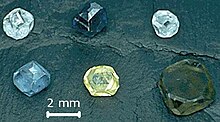

Imperfections in the crystal lattice of diamond are common. Such defects may be the result of lattice irregularities or extrinsic substitutional or interstitial impurities, introduced during or after the diamond growth. The defects affect the material properties of diamond and determine to which type a diamond is assigned; the most dramatic effects are on the diamond color and electrical conductivity, as explained by the electronic band structure.
The defects can be detected by different types of spectroscopy, including electron paramagnetic resonance (EPR), luminescence induced by light (photoluminescence, PL) or electron beam (cathodoluminescence, CL), and absorption of light in the infrared (IR), visible and UV parts of the spectrum. The absorption spectrum is used not only to identify the defects, but also to estimate their concentration; it can also distinguish natural from synthetic or enhanced diamonds.[1]
- ^ Collins, A. T. (2003). "The detection of colour-enhanced and synthetic gem diamonds by optical spectroscopy". Diamond and Related Materials. 12 (10–11): 1976–1983. Bibcode:2003DRM....12.1976C. doi:10.1016/S0925-9635(03)00262-0.
© MMXXIII Rich X Search. We shall prevail. All rights reserved. Rich X Search
